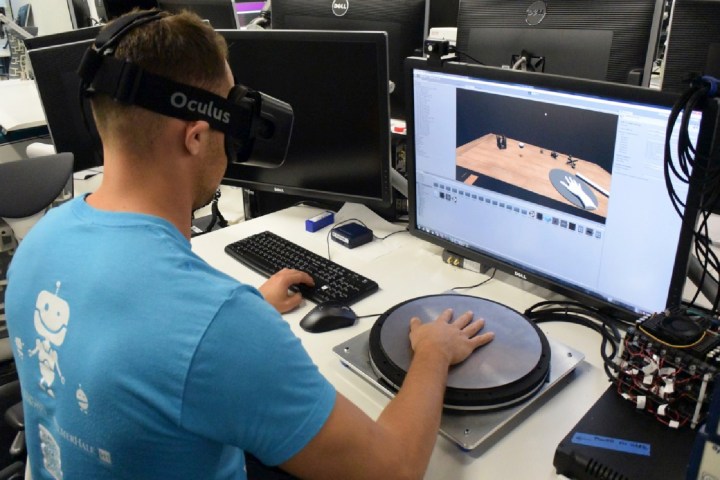
Called HapticWave, the technology takes the form of a circular metal plate attached to a ring of electromagnet actuators, capable of sending a range of vibrations to users’ hands. Depending on the vibration, it will be possible to simulate different objects. For example, heavier objects colliding in virtual space can be simulated using low-frequency vibrations, while higher vibrations could mimic the impact of smaller objects. Accompanying spatial audio systems could complete the effect.
In a demo of the technology, due to be exhibited at this month’s Siggraph computer graphics and interaction conference, Oculus researchers will show how an animated ball can be simulated bouncing across a table — with varying degrees of vibration depending on where it is on the table. Users can control the movement of the ball using a keyboard.
“Our hope around this project was being able to generate this extrasensory input so users can be more perceptive and more believable of virtual objects,” Ravish Mehra, a research scientist at Oculus, told MIT Technology Review.
At present, HapticWave remains a research project, and Oculus won’t confirm whether or not it’s likely to ship to customers any time soon. It also isn’t the only company interested in haptic technology. Just about every big tech company has taken a crack at the concept in recent years, either to work as an interface element or simply for added immersion in tools like VR.
Recently, researchers at the IEEE Haptics Symposium in Philadelphia presented a so-called “acoustic time-reversal processing” technique that uses ultrasound transmitters to send ultrasound waves through a user’s hands — resulting in a touchscreen which touches users back.
If Oculus can successfully get next-gen haptic technology to live up to its potential — and then go on to commercialize it — it could be a massive boon for not just the Rift headset, but for virtual reality as a whole. Color us excited!
Editors' Recommendations
- We finally might know what Apple will call its AR/VR headset
- This futuristic haptic vest should make virtual reality feel more realistic
- The future of immersive VR? ‘Chemical haptics’ applied to your skin
- The best VR games
- It’s no gym. But VR fitness made sweating fun again


